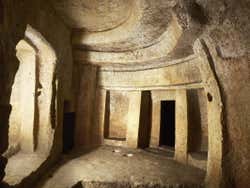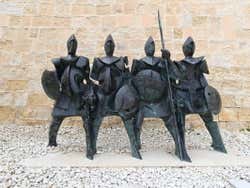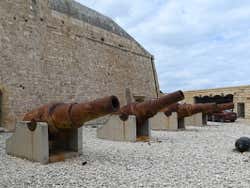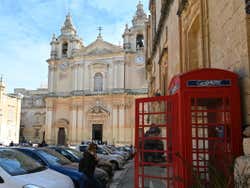
History of Malta
The strategic location of Malta between Europe, North Africa and the Middle East has led to many individuals being interested in the archipelago, which has played a key role in the history of many countries.
Even though Malta is one of the smallest countries in continental Europe, its role has been key in its history. Since the first prehistoric settlers in the year 5,000 BC up to its entry into the European Union in 2004, Malta has been the subject of occupation by many different groups of people which has in turn shaped its architecture, language and culture.
Prehistory and Neolithic Temples
The first settlers in Malta date back to the year 5000 BC, when a group of hominids arrived in neighbouring Sicily and began to populate the islands of Gozo and Malta. These first communities carved limestone by using highly advanced techniques which allowed for the construction of the temples of Hagar Qim, Tarxien and Ggantija, dedicated to the goddess of fertility and built sometime between 3600 and 2500 BC.
The importance of these megalithic temples is undeniable, as they were built before both the Pyramids of Egypt and Stonehenge. The most valuable prehistoric object in Malta is The Sleeping Lady, which was found underground in the Hypogeum Temple of Hal Saflieni and is now on display at the National Museum of Archaeology.
The first inhabitants of Malta and the builders of all these temples suddenly disappeared without a trace.
Phoenicians, Carthaginians, Romans and Arabs
From 800 BC Malta belonged to the Phoenicians, who used the islands as a type of provisions stop on their routes through the Mediterranean. They were then succeeded by the Carthaginians from Northern Africa, who occupied the island for over 250 years.
The Roman Empire took control of Malta during the Second Punic War. During Roman times, the island experienced a rather prosperous period. The size of the cities tripled and many major urban improvements were made.
According to the Bible, Saint Paul the Apostle disembarked in Malta in the year 60 AD and spread Christianity around the whole archipelago. It's believed that he sought refuge in the Catacombs of St. Paul and lived for a short time in Mdina, before returning to Rome to stand trial.
After the dissolution of the Western Roman Empire, the Byzantines occupied Malta for almost 4 centuries, until the Arabs arrived at the end of the 9th century. The population converted to Islam to avoid reprisals and also adopted some of its customs. The Maltese language comes from Arabic and has many of the same sounds.
Early Middle Ages in Malta
In the year 1090, the history of Malta took an unexpected turn when the Normans of Sicily arrived on the island and seized power from the Arabs. When the Crown of Aragon then seized power from Sicily in the 13th century, Malta became part of its new-found territory.
In 1530, the Monarch, Charles V, who had successfully unified the kingdoms of Castile and Aragon, passed Malta onto the Knights of the Order of Jerusalem, in exchange for the symbolic gift of a falcon every year.
The Knights of the Order in Malta
The Knights of the Order of Saint John were established in the year 1530, after having been exiled from Jerusalem by the Ottoman Empire. For 250 years they were in Malta, during which time they brought about some profound changes and restorations to the island in every sense.
They built important bastions and defensive structures, like Fort Saint Elmo and established Senglea, Cospicua and Vittoriosa, the Three Cities of Malta. Without a doubt, the great contribution of the knights was to endow the island with its most well-known emblem: the eight-pointed cross. Each is believed to represent one of the eight nationalities of the knights.
One of the greatest achievements of the Hospitaller knights was resisting the Great Siege of Malta and fighting off the Ottoman troops who tried to invade the island with double the amount of military might. After the knight's victory, the master of the Order Jean Parisot de la Valette founded the capital of Malta: Valletta.
In 1798, Napolean's troops took Malta and exiled the Knights of the Order. The Maltese people rebelled forcing the French to retreat and find refuge in Fort Saint Elmo. The populace asked for help from Great Britain, and 2 years later the English troops arrived at the island... to stay.
Malta during British rule
The British soon understood the value of Malta as a colony in the Mediterranean and through the Treaty of Paris in 1814, Malta became a part of the British Empire. During the nearly 150 years of British occupation, the Maltese adopted many English customs, such as the language, business hours and driving on the left.
During the Second World War, the aerial forces of the Axis powers bombed Malta and reduced many important cities to dust. Just 3 Maltese planes fought against the Italian and German air forces, without stopping. The British King, George VI, awarded the people of Malta the Saint George's Cross for their heroism during the war. Today, this cross is displayed on the Maltese flag.
From British independence to the present day
Malta gained independence from the Crown in 1964 but retained Queen Elizabeth II as their sovereign. 10 years later, Malta's history changed when the country finally became a republic free from British rule, although the British generals did not withdraw from the islands until 1979. Today, Malta is a member of the Commonwealth.
With the acceptance of Malta into the European Union in 2004, the country received funds that were used to enhance the value of its historical heritage.
Nowadays, Malta is an important tourist destination for its beaches and coves, its nightlife and its many tourist attractions. In addition, it also receives many international students each year who come to the islands to learn English.






